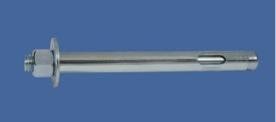
Press Release (ePRNews.com) - CLEVELAND - May 23, 2017 - Mastering the application of the sleeve anchor is a skill most likely learned early in the careers of those who work with concrete fasteners. Did you know that there might be several tips that will help finesse the installation of this versatile anchor?
Expansion. Relying on the time-proven principle of expansion, the sleeve anchor works when the tightened nut pulls the cone-shaped stud end into the expander sleeve, wedging it outward to lock the anchor into the base material of concrete, brick and block materials. It’s crucial that the hole is totally cleared of all debris that may have fallen during the drilling process, or the application may not be as secure as possible. (If not all of the concrete cuttings could be removed from the hole, refer to “Length” section below.) Using a hammer drill and a carbide bit with a size bit equal to the sleeve anchor’s diameter is another critical factor for the most effective expansion.
Length. It is necessary to do a few simple calculations when determining the length of the sleeve anchor that will be best for the job. Use the length of the sleeve anchor, which needs to equal the minimum embedment, and then add the fixture thickness, nut and washer lengths. The sleeve anchor does not require a maximum hole depth, but the depth of the hole into the base material should be at least the length of the sleeve anchor minus the thickness of the material being fastened. This equation will provide a bit of extra depth to accommodate that small amount of concrete cuttings that perhaps were unable to be retrieved from the hole.
Spacing. It might not be commonly acknowledged, but if the sleeve anchors are spaced too close to each other, their holding power may be reduced due to the interaction of forces in the material. Anchors should be spaced a minimum of ten anchor diameters apart and five anchor diameters from an unsupported edge. However, it is extremely important to increase the spacing when the load conditions include vibration or sudden impact.
Purchasing. Purchasing managers and contractors find buying online direct from the manufacturer makes more sense compared to going through distributors. This approach offers the advantages of filling high quantity orders from a fully stocked inventory, which translates into the capability of having sleeve anchors immediately shipped as one order from one location.
Moving beyond the usual habit of purchasing sleeve anchors from a distributor produces savings of 30 to 70% over retail pricing. Ordering online at using their simple and secure shopping cart saves time. The Confast website also offers individual product pages backed up by personalized customer assistance. As a bonus given to their online customers, the company waives all shipping charges.
For more information on Confast Sleeve Anchors:
http://r20.rs6.net/tn.jsp?f=001glPyLPPLFlkkkZoBikDgSXjoAd…